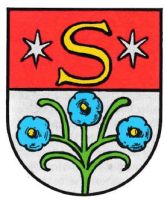Gleiszellen-Gleishorbach: Difference between revisions
Jump to navigation
Jump to search
Knorrepoes (talk | contribs) m (Text replacement - "/Arms of " to "/Arms (crest) of ") |
Knorrepoes (talk | contribs) m (Text replacement - "{{media}}" to " {{de1}} {{media1}}") |
||
| Line 32: | Line 32: | ||
</gallery> | </gallery> | ||
{{ | |||
{{de1}} | |||
{{media1}} | |||
[[Civic Heraldry Literature - Germany|'''Literature''']]: Debus, 1988 | [[Civic Heraldry Literature - Germany|'''Literature''']]: Debus, 1988 | ||
Revision as of 11:34, 26 December 2022
This page is part of the German heraldry portal Deutsche Wappensammlung |
Heraldry of the World |
|
German heraldry:
|
Selected collector's items from Germany:
|
GLEISZELLEN-GLEISHORBACH
State : Rheinland-Pfalz
District (Kreis) : Südliche Weinstrasse
Verbandsgemeinde: Bad Bergzabern
| German | Von Rot und Silber geteilt, oben zwischen zwei sechsstrahligen silbernen Sternen ein sowohl einem S als auch einem G gleichendes goldenes Zeichen, unten drei blaue Blumen mit goldenen Butzen an grünem Stiel. |
| English | No blazon/translation known. Please click here to send your (heraldic !) blazon or translation |
Origin/meaning
The arms were officially granted on August 12, 1982.
The arms are based on the common seal of the two villages, known since 1596. The upper half showed a letter, probably a G, and two stars. These probably refer to the two villages and can also be seen as a symbol for justice.
The lower half refers to the Abbey of Klingenmünster, to which the area historically belonged.
Prior to 1982 the municipality used the same design, but the historical G was somehow changed into a letter S.
Literature: Debus, 1988



